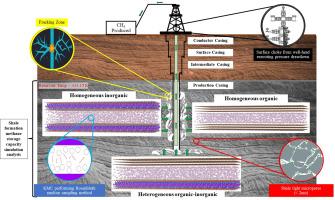Depressurization-induced production of shale gas in organic-inorganic shale nanopores: A kinetic Monte Carlo simulation
Q1 Chemical Engineering
引用次数: 0
Abstract
Methane gas production from unconventional reservoirs, such as shale formations, is in high demand due to the global energy needs. However, maximizing production remains challenging due to the ultra-tight porosity, heterogeneity, and complex nature of shale rocks under high pressure. To address this issue, we employ a novel kinetic Monte Carlo (kMC) simulation to investigate the molecular-level behavior of shale gas in both homogeneous and heterogeneous organic-inorganic shale nanopores. This approach not only provides accurate computations of shale gas under high pressure but also aims to uncover the mechanisms of shale gas storage at reservoir pressure and production during pressure drawdown. Our findings indicate that organic shale ultramicropores (pore width < 0.7 nm) contribute significantly to the highest storage capacity of shale gas but pose challenges for production capacity solely through depressurization. In contrast, the free gas zone is the primary source of shale gas production from mesoporous shales, which has a high recovery efficiency but a low production capacity due to less pronounced interaction effects from the shale surface. The heterogeneous nature of shale surfaces leads to asymmetric distributions of density and potential energy across pore widths, with methane molecules favoring locations near organic pore walls due to stronger attractive interactions, while inorganic pore walls facilitate shale gas migration. Interestingly, the optimal ultramicropore size yields the highest recovery efficiency of shale gas via depressurization, characterized by a transition from near-commensurate to incommensurate molecular packing between reservoir and post-drawdown pressures. Based on these detailed molecular simulations, further research is necessary to develop innovative techniques for enhancing shale gas recovery, especially in micropores.

有机-无机页岩纳米孔中减压诱导的页岩气生产:蒙特卡罗动力学模拟
由于全球能源需求,从页岩地层等非常规储层中生产甲烷气体的需求量很大。然而,由于页岩在高压下具有超紧密的孔隙度、异质性和复杂性,最大限度地提高产量仍是一项挑战。为了解决这个问题,我们采用了一种新颖的动力学蒙特卡洛(kMC)模拟方法来研究页岩气在均质和异质有机-无机页岩纳米孔中的分子级行为。这种方法不仅能对高压下的页岩气进行精确计算,还能揭示页岩气在储层压力下的储存机制和在压力下降时的生产机制。我们的研究结果表明,有机页岩超微孔隙(孔隙宽度为 0.7 纳米)对页岩气的最高储存能力贡献巨大,但仅靠减压对产能构成挑战。相比之下,游离气区是中孔页岩页岩气生产的主要来源,由于页岩表面的相互作用效应不明显,游离气区的页岩气采收效率较高,但产能较低。页岩表面的异质性导致密度和势能在各孔隙宽度上的不对称分布,甲烷分子由于较强的吸引力相互作用而偏爱靠近有机孔隙壁的位置,而无机孔隙壁则有利于页岩气的迁移。有趣的是,最佳超微孔尺寸可通过减压产生最高的页岩气回收效率,其特点是在储层压力和减压后压力之间,分子堆积从接近相称过渡到不相称。基于这些详细的分子模拟,有必要开展进一步研究,以开发创新技术,提高页岩气的采收率,尤其是在微孔中的采收率。
本文章由计算机程序翻译,如有差异,请以英文原文为准。
求助全文
约1分钟内获得全文
求助全文
来源期刊

International Journal of Thermofluids
Engineering-Mechanical Engineering
CiteScore
10.10
自引率
0.00%
发文量
111
审稿时长
66 days
 求助内容:
求助内容: 应助结果提醒方式:
应助结果提醒方式:


